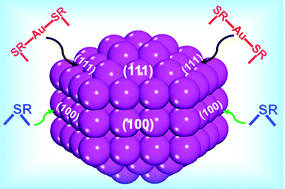Beyond the staple motif: a new order at the thiolate–gold interface†
Abstract
Staple motifs in the form of –RS(AuSR)x– (x = 1, 2, 3, etc.) are the most common structural feature at the interface of the thiolate-protected gold nanoclusters, Aun(SR)m. However, the recently solved structure of Au92(SR)44, in which the facets of the Au84 core are protected mainly by the bridging thiolates, challenges the staple hypothesis. Herein, we explore the surface sensitivity of the thiolate–gold interface from first principles density functional theory. We find that the interfacial structures of thiolates on gold are surface sensitive: while a staple motif (such as –RS–Au–SR–) is preferred on Au(111), a bridging motif (–RS–) is preferred on Au(100) and Au(110). We show that this surface sensitivity is closely related to the coordination number of the surface Au atom on the different surfaces. We further confirm the preference of the bridging motif for self-assembled monolayers of two different ligands (methylthiolate and 4-tert-butylbenzenethiolate) on Au(100). With this surface sensitivity, we categorize the structure-known Aun(SR)m clusters into three groups: (1) no bridging; (2) ambiguous bridging; (3) distinct bridging. We further employ the surface sensitivity of the thiolate–Au interface to predict the protecting motifs of face-centered cubic (fcc) gold nanoparticles of different shapes. Our study provides a unifying view of the Aun(SR)m structures with guidelines for structure predictions for larger Aun(SR)m clusters of a fcc core.


 Please wait while we load your content...
Please wait while we load your content...